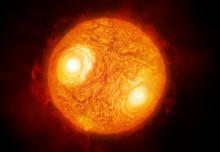Listen to today's episode of StarDate on the web the same day it airs in high-quality streaming audio without any extra ads or announcements. Choose a $8 one-month pass, or listen every day for a year for just $30.
You are here
Moon and Antares
A star and an onion might not seem to have much in common. But as the heaviest stars near the ends of their lives, they’re put together a lot like an onion.
All stars begin their lives by “fusing” atoms of hydrogen in their cores to make helium. When they’ve used up the hydrogen, gravity squeezes the cores more tightly, making them hotter, so they fuse the helium to make carbon and oxygen.
For stars like the Sun, that’s as far as it goes — they can’t get hot enough to make heavier elements. But stars that are at least 8 to 10 times the mass of the Sun can.
Gravity squeezes them even tighter, allowing the carbon to fuse to make neon and other elements, which takes hundreds of years. It then takes perhaps a year or less for the neon to make oxygen, and as little as weeks for the oxygen to make silicon. Each of these steps leaves a layer of the earlier elements, creating the onion-like structure.
The final step takes just days. The silicon fuses to make iron. It takes more energy than the core can produce for the iron to fuse to make even heavier elements, so the reactions stop. The core collapses, and the outer layers blast into space as a supernova.
One star that will undergo that fate is Antares, which is below the Moon at first light tomorrow, far to the right of the bright planet Jupiter. It’s probably fusing helium in its core right now, so the clock is ticking toward its demise — sometime in the next million years.
Script by Damond Benningfield




